Gold & Precious Metals
Updated: Rock Solid Gold – Timing and Targets from 3 of the Best
Posted by Mark Leibovit - Richard Russell - Charts by Don Vialoux
on Monday, 27 February 2012 23:16
Update February 29, 2012: A key phrase from Mark Leibovit’s VRGold Letter “Action Alert” dispatched today:
“Gold prices were selling off Wednesday after Federal Reserve Chairman Ben Bernanke indicated that an additional round of quantitative easing was becoming increasingly unlikely. We’re experiencing a ‘flash-crash’ type scenario today which in my view presents a bigger picture buying opportunity.” – VRGold Letter
Update 3:18pm Feb 27: Gold (below) has formed a broad head-and-shoulders bottom with the upside breakout coming in at 1800. April gold has been hammering on the 1700 support level for days, and so far 1700 has held. If 1700 won’t give way, then gold should be able to take out 1800. What won’t go down — should go up. At least that’s the theory – written 2/27/2012 in Dow Theory Letters
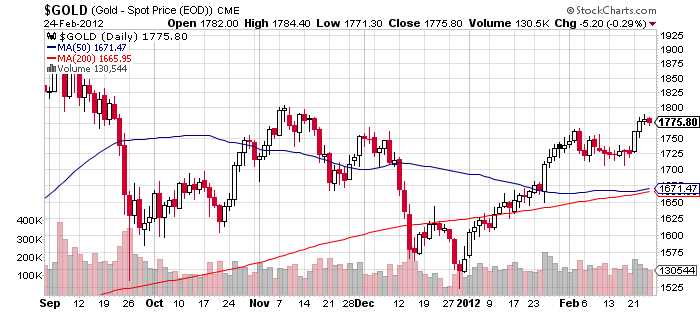
Meanwhile, gold pops 20 bucks. Pick a hammer and hammer down on a wood board 20 times. The board doesn’t break, which means that’s a mighty tough board. Now hammer down on 1700 dollar gold 20 times. And the 1700 base refuses to give. So you know that 1700 is a tough base for gold. Today April gold closed up over 32 dollars to 1758.50. This puts gold over the halfway point of 1750 and looking at 1800. If gold won’t break below 1700, will it go over 1800? There’s at least a good chance. – written 2/21/2012 in Dow Theory Letters
GOLD – ACTION ALERT – BUY
(written Feb 27/2012)
Spot gold touched 1789.10 Thursday and retraced to 1769.20 on Friday. We should have seen 1764.00. Downside risk is back to the 1730s should we see another ‘smackdown’. Next upside objective 1840. Spot silver continued high Friday trading at 35.84. I would like to see a pullback to 34.60. Still targeting to 37 and then the low 40s. Copper pushed higher touching 3.8823. It’s coming off 3.702. That was the recent low following the February 8 high at 3.9850. I’m looking for 4.48+. Both Palladium and Platinum corrected Friday following new recovery highs Thursday at 729 and 1740, respectively. – Sign up for a 30 Day Trial offer with Mark Leibovit’s VRTrader. More information at the end of this article.
Gold, Silver, Platinum & TSE Gold Index Charts & Technical Analysis below by Don Vialoux:
Gold gained $49.50 per ounce (2.87%) last week. Support is at 1,523.90. Resistance at $1,804.40 is being tested. Short term momentum indicators are overbought, but have yet to show signs of peaking. Strength relative to the S&P 500 Index remains slightly positive.

Silver gained $2.14 per ounce (6.43%) last week. Intermediate trend changed from down to up on Friday after resistance at $35.70 was broken. Silver also broke above its 200 day moving average on Friday. Short term momentum indicators are overbought, but continue to trend higher. Strength relative to gold remains slightly positive. ‘Tis the season for silver to move higher!

Platinum gained another $87.50 per ounce (5.37%) last week. Intermediate trend changed from down to neutral on a break above resistance at $1,676.40 per ounce. Platinum also broke above its 200 day moving averages last week. Short term momentum indicators are overbought, but continue to trend higher. Strength relative to gold remains positive. ‘Tis the season for platinum to move higher!
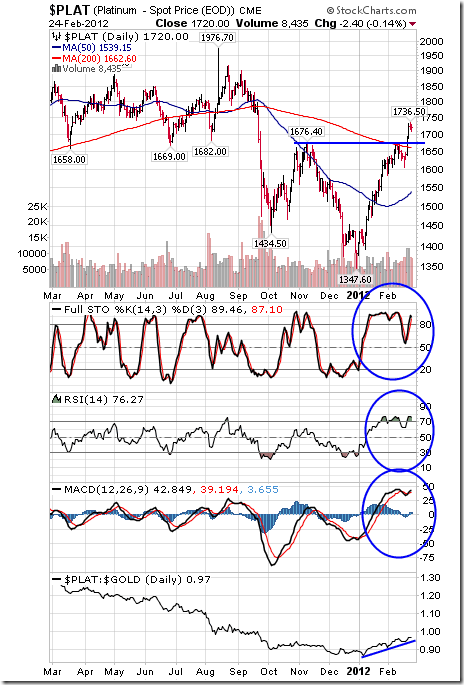
The TSX Gold Index gained 16.47 points (4.46%) last week. Support is at 346.24 and resistance is at 395.64. Short term momentum indicators are trending down. Strength relative to gold remains negative.
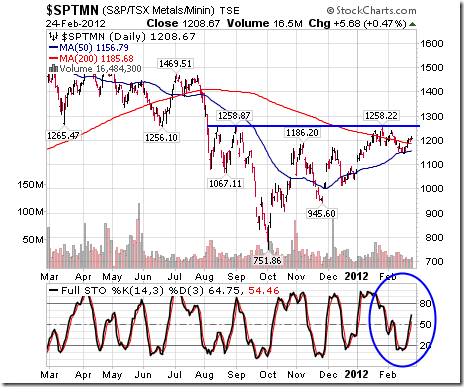
VRTRADER.COM Trial Signup:
THE RENEWAL OF YOUR SUBSCRIPTION IS AUTOMATIC. YOUR CREDIT CARD WILL CONTINUE TO BE BILLED UNLESS YOU NOTIFY VRtrader.com SEVEN DAYS PRIOR TO SUBSCRIPTION EXPIRATION EITHER VIA EMAIL POSTING THE WORD ‘UNSUBSCRIBE’ IN THE SUBJECT BOX OR TELEPHONE US AT (928) 282-1275 OF CANCELLATION. NO REFUNDS ARE AVAILABLE ON SILVER, PLATINUM OR VR FORECASTER (ANNUAL FORECAST MODEL) SUBSCRIPTIONS.
Welcome and congratulations on choosing VRTrader.com as a source for your stock market commentary, information and analysis for the U.S. Stock Market. Needless to say we are very happy that you are joining us for AT LEAST the next 30 days days and look forward to providing you rewarding and inciteful information that will help you toward your goal of succeeding in the markets.
Here is the Special Trial Offer: Use this month to kick our tires. Pay 50% for the first 30 days (No refund) and sample our Silver or Platinum service and then decide what works best for you. If you aren’t 100% ready to move forward, simply email us to cancel one week before your 30 day 50% off trial subscription ends and it will be canceled and you will not be charged ANY FURTHER, no questions asked. Just send an email to mark.vrtrader@gmail.com” data-mce-href=”mailto:mark.vrtrader@gmail.com“>mark.vrtrader@gmail.com or call 928-282-1275 to cancel. You will receive an emailed confirmation of your cancellation at that time.
The 30 day trial is allowed one time only. By taking this 30 day 50% trial, you agree to be charged the full cost of the monthly Silver or Platinum service (choose one only) at the end of the 30 day trial subscription period, unless you cancel first. The regular Silver monthly rate is $49.40 and the Silver quarterly rate is $133.50. The regular Platinum monthly rate is $129.95 and the Platinum quarterly rate is $350.85. The special trial 50% off trial rates are listed below. Sign up today!
There are no refunds or pro-rata refunds offered at VRTrader.com for any subscription. You are being offered a 50% discount for trying our service for the first 30 days only!

Take Advantage ofl Metals and Mining Paradigm Shift – Exiting Easy And Economica
Posted by Richard Mills: Ahead of the Herd
on Monday, 27 February 2012 13:11
“Markets are reasonably efficient, most of the time, at setting prices. Where they are most likely to fail, though, is in correctly anticipating and pricing big, revolutionary, ‘paradigm’ shifts — whether a rise of disruptive technologies or revolutionary changes in geopolitics. We are living through one now.” – Crispin Odey
Ed Note: Be sure to read through to the conclusion at the bottom of this article:
Metals and Mining Paradigm Shift, Exiting Easy And Cheap
The massive growth of global prosperity over the last five centuries has been driven by easy and cheap access to critical materials:
- Food
- Fibre
- Energy
- Minerals
However since October 2001 the CRB BLS Spot Index has reached record levels.
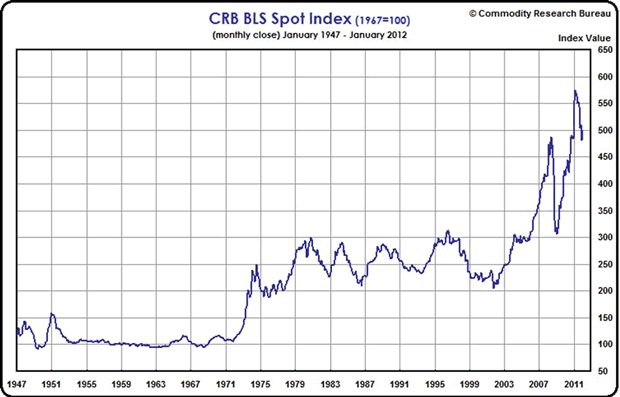
The Spot Market Price Index is a measure of price movements of 22 basic commodities. The spot price is the price at which a commodity is selling for immediate delivery.
Commodity price rises could be caused by:
- Raw materials shortages
- Resource nationalism
- Emerging market demand
- Speculation
- Intense weather pattern changes
- War
- Inflation
- Hoarding
- Low interest rates
Many people might assume that out of all the reasons given these three would be the main drivers:
- War
- Inflation
- Emerging market demand
Inflation & War
Because central banks can increase the supply of money virtually at will, and do so, the value of all existing money decreases. The amount of goods and services remains the same, but now the amount of money chasing them has increased, this increased competition – more money (inflation) for the same amount of goods and services – causes prices to rise.
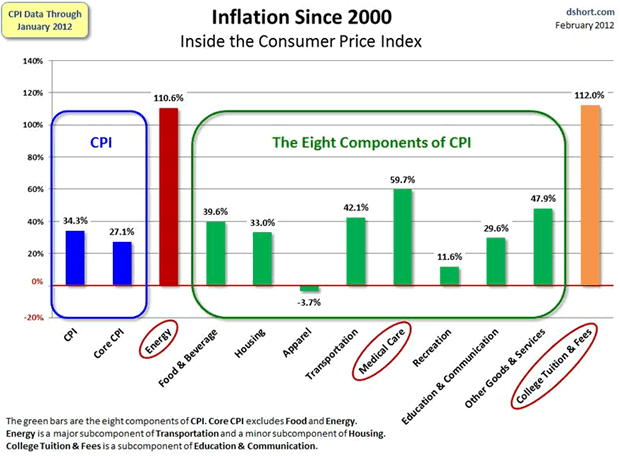
Governments and Central Banks want slowly rising prices. They pour money into the market to encourage growth so prices increase rather than decrease. Price decreases, or deflation (less money growth), slows economic activity – if people think prices are going to be lower next week they will not buy today, they will wait, this leads to a contraction in economic activity, something all governments fear.
Low interest rates play their part as well. When governments lower interest rates to stimulate borrowing businesses expand and consumers borrow to buy homes, cars and other goods. Demand for goods and services increase and so to do prices of commodities used in manufacturing.
Nations in Europe, and the U.S. will inflate (print more of) their currencies rather than cutting back spending or raising taxes. In a global race to worthless Asian economies will also have to print massive amounts of their currencies so they stay weaker then the US dollar. Asian exports have to be cheap for American consumers and American exports have to be more expensive then locally produced goods.
The buildup to war, and the actual running of a war is expensive. Governments will typically devalue their currencies by printing the money needed – very few people would ever consent to go to war if they were made to pay for it out of their pockets. How many Americans would consent to the trillions of dollars necessary for America’s endless wars and vast military complex if the money required came directly off their paycheques? Government control over the money supply makes the business of war easy to finance because the financial support of its citizens is not needed.
Actual war does not seem to be one of the main causes of the decade long commodities price increase, rather it’s the creation of the money necessary to go to war – government created inflation. In regards to recent wars, we haven’t had a global conflict, and the resultant massive global destruction and rebuilding, since World War II. Wars today are localized affairs and do not bring about the massive use of commodities for rebuilding as a global conflict would.
Throughout history periods of rising money supply growth has coincided with rising commodity prices, and falling money supply growth coincided with periods of falling commodity prices.
A key driver of higher commodity prices, global government sponsored inflation (and quite likely continuing war inflation) are locked in place for years to come.
Developing Country Demand
China’s plus nine percent annual growth, and other developing nations growth (averaging much less), are usually named as the biggest cause of price rises in the commodities markets. China has been growing at plus nine percent annually for well over two decades. Compounded that’s a lot of growth, add in other developing countries growth then realize a considerable period of this growth was spent in the commodity bear market. The growth story is suddenly an overnight sensation, inflations effects start to percolate, wars are started and speculators play.
A mismatch between demand and supply is not a new problem in commodity markets. It can and does take years to find and develop new resources and bring the commodities to market. If war and emerging country demand cause prices to rise – shortage caused price spikes – an increase in production (after a war or ramping up for developing country demand) would satisfy increased demand. But it hasn’t happened yet and it’s been over a decade since commodity prices have gone on their spectacular run.
So far inflation would seem to be the driver for commodity price increases, everything else seems temporary or if permanent, such as developing country demand, fixed with an increase in production.
But
There is a major paradigm shift taking place in the mining industry and it concerns the supply, not the demand side we hear so much about.
Supply
Supply shortages always lead to high enough metal prices for further increases in production, thus supply will eventually exceed demand and prices will drop…right? Well maybe, maybe not. Margins (not price) motivates investment and if the cost of metal production is increasing margins might not be sustainable.
Lets state the obvious:
- For over the last ten years supply has struggled to keep pace with demand
- Metal supply is finite and subject to compounding demand from developing nations
- Metal production is highly cyclical, with intermittent peaks and troughs which are closely linked to economic cycles – declining production has historically been driven by falling demand and prices, not by scarcity
- Rates of production and amounts of reserves continually change in response to movements in markets and technological advances
- Most mineral resources will not be exhausted in the near future
- If energy was cheap and unlimited then recoverable resources would be unlimited
But
- Discovery and development is increasingly becoming more challenging and expensive
- Average ore grades are in decline for most minerals, yet production has increased dramatically
- Our most important metals are suffering from declining ore quality and rising extraction (ore is a different and inferior chemical or structural composition) costs
- Our prosperity has always been based on the fact that producing resources yielded more resources than it cost. However the cost of *energy is climbing, the amount used is climbing but the returns from energy expended is declining. Eventually the quantity of resources used in the extraction process will be 100% of what is produced
- Most older existing mines, the foundation of our supply, have increasing costs with production rates stagnating or even declining
- The rate of discovery is not keeping pace with the rate of depletion, let alone being higher
*Energy can be thought of as a proxy for labor, materials, energy and externalities – environmental, community impact etc.
Copper and Gold as Proxies
The metal content of copper ore has been falling since the mid 1990s. A miner now has to dig up an extra 50 percent of ore to get the same amount of copper. As grade drops the amount of rock that must be moved and processed per tonne of produced copper rises dramatically – all the while using more energy that costs several times more than it use to. With the lower grades of ores now being mined energy becomes more and more of a factor when considering economics.
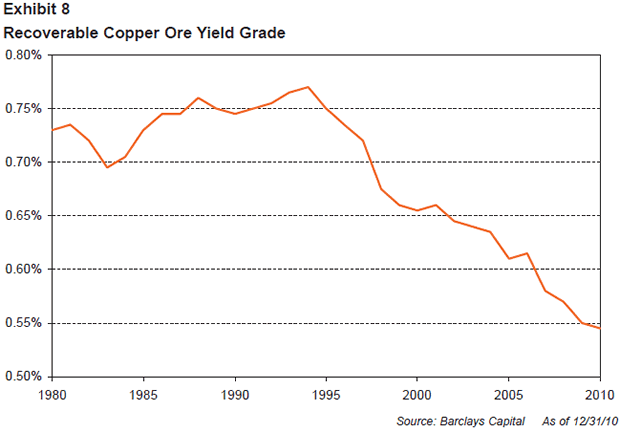
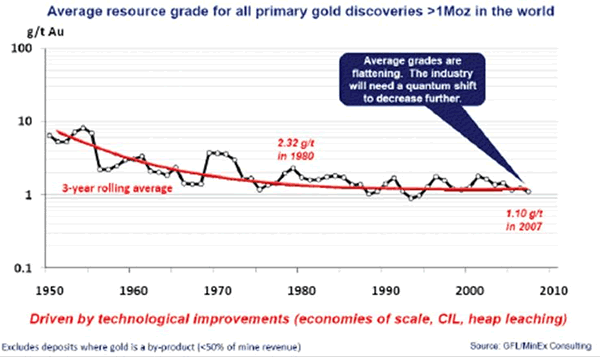
Conclusion
Complicated more expensive extraction of metals from increasingly harder to find, lower grade ore bodies in almost inaccessible and hostile parts of the world is going to affect our lifestyles.
What changes are we going to have to make as nature – the finite supply of materials and energy constraints – dictates lifestyles and aspirations?
“We took the nice, simple, easy stuff first from Australia, we took it from the U.S., we went to South America. Now we have to go to the more remote places.” Glencore CEO, Ivan Glasenberg in the Financial Times describing why his firm operates in the Congo and Zambia
We are experiencing a paradigm shift. If nothing else, right now at this point in history, we all have to realize that the mining industry is exiting “easy & cheap” and is starting the upward slope of chronic lower supply, permanently higher prices and higher risk.
We all have to agree that the planet’s booming population and rising standards of living are going to put unprecedented demands on supply.
This should be on everyone’s radar screen. Is it on yours?
If not, maybe it should be.
By Richard (Rick) Mills
www.aheadoftheherd.com
If you’re interested in learning more about specific lithium juniors and the junior resource market in general please come and visit us at www.aheadoftheherd.com. Membership is free, no credit card or personal information is asked for.
Copyright © 2012 Richard (Rick) Mills – All Rights Reserved
Legal Notice / Disclaimer: This document is not and should not be construed as an offer to sell or the solicitation of an offer to purchase or subscribe for any investment. Richard Mills has based this document on information obtained from sources he believes to be reliable but which has not been independently verified; Richard Mills makes no guarantee, representation or warranty and accepts no responsibility or liability as to its accuracy or completeness. Expressions of opinion are those of Richard Mills only and are subject to change without notice. Richard Mills assumes no warranty, liability or guarantee for the current relevance, correctness or completeness of any information provided within this Report and will not be held liable for the consequence of reliance upon any opinion or statement contained herein or any omission. Furthermore, I, Richard Mills, assume no liability for any direct or indirect loss or damage or, in particular, for lost profit, which you may incur as a result of the use and existence of the information provided within this Report.
© 2005-2012 http://www.MarketOracle.co.uk – The Market Oracle is a FREE Daily Financial Markets Analysis & Forecasting online publication.

Gold Stocks Nearing the End of the Wall of Worry Stage
Posted by Jordan Roy-Byrne - TheDailyGold.com
on Friday, 24 February 2012 14:00
“Gold stocks are following a typical bull market which evolves in three stages: the stealth phase, the wall of worry phase, then the bubble or public phase.” “Momentum has subdued for almost two years while the gold stocks have not had a rip roaring breakout to new highs since early 2006!” “We are essentially looking at a potential breakout from a multi-year base.”
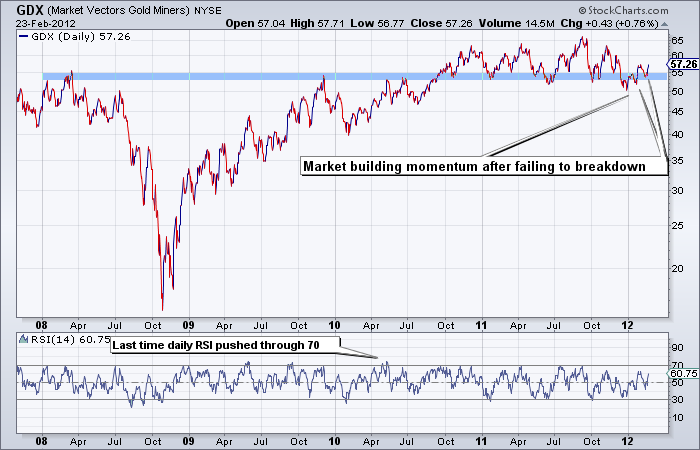
….read more HERE

Precious Metals Monitor: Both Gold & Platinum to Break $1900, But One Has More Upside
Posted by Hard Assets Investor
on Thursday, 23 February 2012 13:02
We offer our latest analysis on the precious metals market.
After two weeks of consolidation, precious metals finally awoke from their slumber over the past few days. Gold, silver and palladium spiked to the top of their recent ranges, while platinum broke out to fresh multi-month highs.
A strike at the world’s largest platinum mine, Rustenburg in South Africa, has led to the loss of more than 80,000 troy ounces of the metal over the past month. The mine’s operator, Impala Platinum, said resumption of full production will take weeks, at least.
Analysts warn that the situation could get uglier if labor unrest spreads to other companies.
South Africa’s total output was 4,775,000 troy ounces in 2011, which represented 75 percent of global output.
Prices for platinum have surged in recent sessions, now trading at a five-month high. The metal is quickly closing in on parity with gold prices.

After the recent breakout, prices have a clear path toward the multi-year high above $1900, leaving substantial upside from here.
While gold also has been performing well, the gold/platinum ratio has been quickly falling amid platinum’s outperformance. It was last trading near 1.02 after peaking above 1.15 late last year.
Over the past three decades, the ratio has been significantly below 1. Thus, continued platinum outperformance over gold would not be surprising as the ratio declines further.
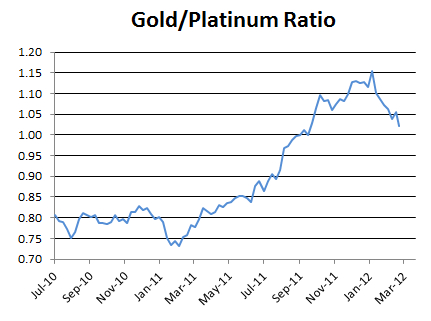
Even so, the outlook for gold is bullish as well. The yellow metal moved up to the top of its recent range this past week and looks poised to move toward the next level of resistance at $1800
GOLD
…..read more on Gold, Silver, Palladium, US Dollar and view 25 charts HERE

A Prime Opportunity to Buy Gold Stocks is Imminent
Posted by Steve Saville comment by Mark Leibovit
on Wednesday, 22 February 2012 11:44
Update: Mark Leibovit’s pre-opening Gold Comment for 02/22/12. GOLD – ACTION ALERT – BUY
Metals took off for the same reason stocks rallied. Platinum saw a new recovery high of 1646 along with Palladium which traded at 717. Silver touched 34.58, just four cents under its February 34.62 peak. Gold fell a tad short too touching 1761.50 versus its February 3 peak at 1764.20. The burden of proof is on the bulls here, but ‘seasonality’ for gold is beginning to run out. I would still like to see silver push back toward my projected 30-31 pullback zone. Afterwards, my target is first 37 on its way to 42-43. Gold targets to the mid 1800s and perhaps back to its record 1922 high, but I was thinking we should first see more of a pullback, perhaps into the 1600s. So far, this market has said it has other plans. Stay tuned.
A Prime Opportunity to Buy Gold Stocks is Imminent
The price action of the past six trading days made it clear that contrary to our previous thinking the XAU did not break out to the upside late last month. A definitive upside breakout and confirmation that the intermediate-term correction ended in late December will require a daily close above 205. (last nights close 198.20)
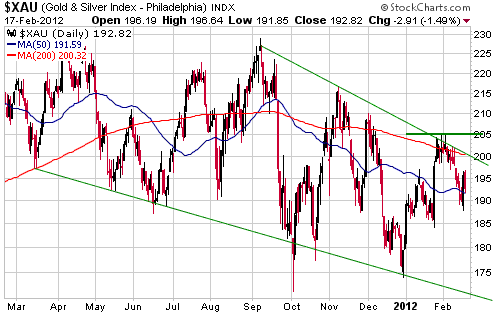
By its nature, confirmation of an important low will usually be belated and will therefore usually not coincide with a good short-term buying opportunity. In general, buying should be done in response to pronounced weakness, not strength. For example, it made more sense to buy near the start of trading on Thursday 16th February, with the gold stock indices having just fallen for 9 days in a row and looking like they were about to extend the losing streak to 10 days, than to buy at the end of January with the XAU appearing to have just broken out to the upside.
It’s possible that the gold-stock indices bottomed on the morning of 16th February, but at this stage the price action is non-committal. If a short-term bottom had been put in place last Thursday it would have been normal for there to be some follow-through to the upside on Friday, so the fact that Friday was another down-day leaves open the possibility that the indices will make new multi-week lows this week.
If a break to new multi-week lows occurs this week it will create an opportunity for under-exposed speculators to do some buying. It won’t, in our opinion, signal that major additional weakness lies ahead. There is a realistic possibility that the HUI and the XAU will test their late-December lows before the end of this month, but very little chance that they will do worse than that before commencing their next tradable rallies.
The mission of The Speculative Investor (TSI) is to provide our subscribers with information that not only helps them understand and profit from changing financial market trends, but is also interesting and thought-provoking.


-
I know Mike is a very solid investor and respect his opinions very much. So if he says pay attention to this or that - I will.
~ Dale G.
-
I've started managing my own investments so view Michael's site as a one-stop shop from which to get information and perspectives.
~ Dave E.
-
Michael offers easy reading, honest, common sense information that anyone can use in a practical manner.
~ der_al.
-
A sane voice in a scrambled investment world.
~ Ed R.
Inside Edge Pro Contributors

Greg Weldon

Josef Schachter

Tyler Bollhorn

Ryan Irvine

Paul Beattie

Martin Straith

Patrick Ceresna

Mark Leibovit

James Thorne

Victor Adair

